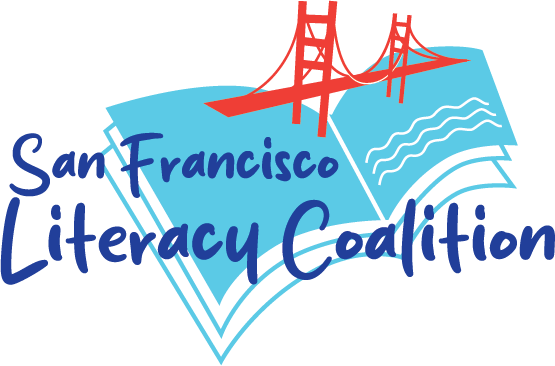We had the chance to talk to Misha Villatuya, the Mission Bay Programs Director at 826 Valencia. As a former elementary school teacher, Misha loves “getting in the weeds” with curricula and has a clear perspective on how alignment between 826 Valencia and SFUSD’s new HMH curriculum – a district-wide science-of-reading-backed literacy curriculum currently in its first year of deployment – can benefit students. We sat down to learn about what alignment means to her, how her team strives to create a cohesive student experience, and the joy in 826 Valencia’s writing prompts!
About 826 Valencia
San Francisco Literacy Coalition (SFLC): What does 826 Valencia do?
Misha Villatuya (MV): 826 Valencia equips students with writing skills to create change. We are a nonprofit organization dedicated to supporting under-resourced students ages six to eighteen with their creative and expository writing skills and to helping teachers inspire their students to write. Our services are structured around the understanding that great leaps in learning can happen with individualized attention and that strong writing skills are fundamental to future success.
SFLC: Why does strong writing instruction matter?
MV: Our students’ voices deserve to be heard by as wide an audience as possible, and we know that strong literacy skills open up endless opportunities.
SFLC: What is your hope for all students who take part in 826 Valencia programming?
MV: I hope that all students that take part in 826 Valencia programming become competent and confident writers. I hope that all students we serve feel deeply seen and know how much their thoughts and opinions matter.
Defining Alignment
SFLC: What does alignment mean to you and your staff?
MV: If we want to provide students with high quality programming, alignment is crucial. We know that routine and predictability allows students to feel a sense of safety and consistency in instructional practices increases engagement, internalization, and growth.
SFLC: Could you give some examples of how you have worked to align 826 Valencia writing instruction in SFLC focal schools this year?
MV: We drafted our writing project scope and sequence based on the HMH literacy spirals, and we’ve adapted the same anchor charts teachers use in our own mini-lessons.
One of our program leads collaborated with the 3rd-5th grade teachers at Charles Drew Elementary School to create a writing rubric that fuses the HMH rubrics and 826 Valencia rubric together. Our goal is to introduce the rubric to every student we serve and use it to grade writing projects throughout the year. If teachers adopt it too, this would enable us all to give students consistent and actionable feedback and track student progress.
SFLC: How do you partner with teachers in your work? What does collaboration look like?
MV: Our program leads meet with partner teachers on a monthly basis. As our Mission Bay Programs Director, I participate in SFLC Drew Convening meetings and facilitate monthly meetings with instructional coaches at Bret Harte and Charles Drew Elementary School and their SFLC Manager, Julianna.
These meetings often involve updates, like schedule changes, upcoming field trips, standardized testing dates, and collaborative problem solving, like seating charts and effective incentive systems. This year, we also introduced focal student tracker that compiles all relevant student data (i.e. STAR assessments, Lexia levels, Writing Benchmark scores) and effective interventions/strategies all providers could use.
Looking Ahead
SFLC: What are you excited about when it comes to HMH and 826 Valencia alignment moving forward?
MV: As a former elementary school teacher and administrator, I’m excited to continue geeking out over curriculum and instruction and see how much our alignment positively impacts student outcomes.
SFLC: What are future 826 Valencia initiatives you’re excited to build upon in the coming school year?
MV: I’m excited to apply teacher feedback to next year’s writing project scope and sequence and use the focal student tracker and rubric right at the beginning of the year. That way, we can analyze student writing on a regular basis and use that data to drive our instruction as well as continuously celebrate growth.
Getting Creative!
SFLC: What’s your favorite 826 Valencia writing assignment? Why?
MV: We’ve had so many good ones this year, but I absolutely loved the travel guides we created about different countries around the world. While kiddos conducted research using the San Francisco Public Library’s database, it was incredible to see their faces twist up in curiosity and beam when they taught tutors and their peers everything they learned.
+++
Want to read some amazing student work? Each year, 826 Valencia publishes powerful, imaginative student writing – click here to read past publications and keep an eye out for this year’s inspiring new releases coming next month!
